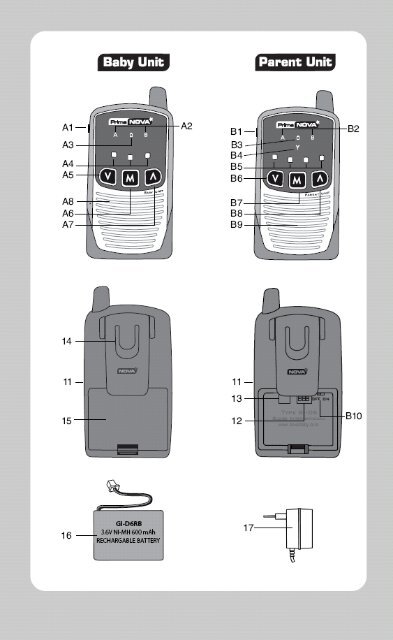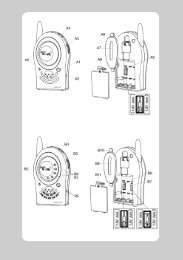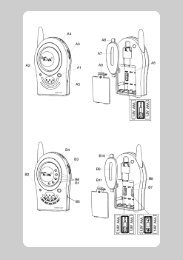Prima NOVA Digital Baby alarm (PDF) - NOVA's Digital Babycall
Prima NOVA Digital Baby alarm (PDF) - NOVA's Digital Babycall
Prima NOVA Digital Baby alarm (PDF) - NOVA's Digital Babycall
You also want an ePaper? Increase the reach of your titles
YUMPU automatically turns print PDFs into web optimized ePapers that Google loves.
Parent unit<br />
B1 On/Off button . . . . . . . . . . . . . . Switches power on or off<br />
B2 Channel indicator. . . . . . . . . . . Shows the channel that has been set. Blinks when the unit is in<br />
standby mode and remains on constantly when it is activated<br />
B3 Low battery indicator . . . . . . . . Blinks when the battery is drained<br />
B4 Range indicator . . . . . . . . . . . . Blinks if there is no contact with the baby unit<br />
B5 Volume indicator . . . . . . . . . . . Blinks to show sound level when the unit is activated. Shows<br />
the volume setting for two seconds when the unit is turned on<br />
and remains on constantly when setting the volume<br />
B6 ▼ button . . . . . . . . . . . . . . . . . Button for lower volume/programming<br />
B7 M button. . . . . . . . . . . . . . . . . . Button for programming/storing<br />
B8 ▲ button . . . . . . . . . . . . . . . . . Button for higher volume/programming<br />
B9 Speaker<br />
B10 Vibrator switch . . . . . . . . . . . . . Switches vibrator function on/off<br />
11 Adapter contact<br />
12 Switches to set digital code . . This is set at the factory, but you can set your own digital code<br />
to avoid unnecessary interference. See detailed instructions<br />
13 Battery pack contact<br />
14 Belt clip<br />
15 Battery compartment . . . . . . . Open to remove battery pack<br />
16 Battery pack. . . . . . . . . . . . . . . NiMH rechargeable battery pack<br />
17 Adapter<br />
All warning sound signals from the parent unit are combined with a blinking symbol in one of the<br />
units showing the cause of the <strong>alarm</strong>. The baby unit only gives a sound signal when turned on or<br />
off, but not if the battery is weak. This means you can avoid waking the baby unnecessarily.<br />
A warning that the baby unit batteries are weak is indicated by a blinking symbol on the baby unit<br />
and a sound signal on the parent unit. If the parent unit emits a sound signal without any red lights<br />
blinking, it is warning that the batteries in the baby unit are weak.<br />
When out of range of the baby unit, the parent unit will indicate this with a sound signal and the<br />
range indicator will blink. This is for safety reasons, as walls, particularly concrete walls, and<br />
ceilings can significantly reduce the range. Metal plates (cars, motor homes) may block reception<br />
of the signal. Relocating the baby unit and/or the parent unit may help because radio signals are<br />
reflected from objects, people etc. This means there will be areas where no communication is<br />
possible even if the range is short.<br />
Detailed instructions<br />
Setting the digital code<br />
<strong>Prima</strong><strong>NOVA</strong> is equipped with a digital code<br />
system DSIP (<strong>Digital</strong> Selectable Interference<br />
Protection) with eight digital codes (1– 8).<br />
The same code MUST be used on<br />
both units! If the DSIP codes or the<br />
set channel (A or B) are different<br />
you will not hear a sound from the child,<br />
and the units will indicate that they are not<br />
communicating with each other!<br />
The digital codes can be set using the switches<br />
(12) in the battery compartment. Each unit has<br />
three switches and the code is set according to<br />
the following table.<br />
3<br />
Code Switch setting Code Switch setting<br />
ON<br />
1 5<br />
1 2 3<br />
ON<br />
2 6<br />
1 2 3<br />
ON<br />
3 7<br />
1 2 3<br />
ON<br />
4 8<br />
1 2 3<br />
ON<br />
1 2 3<br />
ON<br />
1 2 3<br />
ON<br />
1 2 3<br />
ON<br />
1 2 3
V M<br />
V M<br />
V M<br />
V<br />
V<br />
V<br />
<strong>Baby</strong> unit<br />
1. Adjust the channel<br />
Press the M button once, A or B blinks rapidly.<br />
Select the desired channel A or B using the ▲ and ▼ buttons.<br />
Then press the M button to store.<br />
The unit now returns to normal operations.<br />
2. Adjust sound sensitivity<br />
Press the M button and hold until the sensitivity indicator lights.<br />
Adjust desired sensitivity using the ▲ and ▼ button. More arcs indicate higher<br />
sensitivity (one light = low, two lights = medium and three lights = high sensitivity).<br />
Then press the M button to store.<br />
Parent unit<br />
1. Adjust the channel<br />
Press the M button once, A or B blinks rapidly.<br />
Select the desired channel A or B using the ▲ and ▼ buttons.<br />
Then press the M button to store.<br />
The unit now returns to normal operations.<br />
NOTE! If the M button is not pressed within 20 seconds after the last button<br />
press the unit will automatically return to normal operations without storing<br />
the new settings!<br />
Using the charger and batteries<br />
Both units can be used while being charged.<br />
The units are connected to the wall power outlet using the adapters included (17). Only these<br />
adapters must be used.<br />
Plug the adapters into the contact (11) on the baby unit and the parent unit. The<br />
batteries will now be charging and will be fully charged within four to six hours.<br />
The units will then switch to maintenance mode. The batteries will therefore not<br />
be damaged even if they remain connected to the adapter for a long period.<br />
V M 3<br />
Note: Rechargeable batteries are consumables, gradually losing power<br />
when used.<br />
Extra battery packs can be purchased from the dealer. Read the<br />
troubleshooting guide in case of problems.<br />
V<br />
Technical specifications (subject to change)<br />
* 2 sets of environmentally friendly battery packs 3.6V NiMH 600mAh.<br />
* Transmitter frequency: 2 channels, frequency range 863 - 865 MHz.<br />
* Working temperatures: 0°C to +40°C. Storage temperature: -20°C to +40°C.<br />
* Output rating baby unit < 10mW.<br />
General<br />
The authorities have assigned only a limited number of frequencies and a very limited transmitter<br />
power rating to electronic baby monitors. Interference may therefore occur from other baby monitors<br />
while your baby unit has been activated by sounds from your child(traffic interference). This is<br />
normally heard as distortion and/or screeching/beeping sounds in the speaker. If this occurs, try to<br />
switch channels and select a lower sensitivity to prevent it from being activated due to weak<br />
sounds/movement from your child. If this does not help, there is nothing else that can be done, but<br />
4
it was after all sounds from your child that activated your parent unit, so you have not been alerted<br />
unnecessarily! Distortion during transmission may thus be expected because units in the same area<br />
normally use the same frequency.<br />
This is not a problem when your <strong>Prima</strong><strong>NOVA</strong> is on standby: You will not be disturbed unless another<br />
<strong>Prima</strong><strong>NOVA</strong> has been adjusted to identical codes and channels, in contrast to other baby monitors.<br />
Also bear in mind that radio signals may be blocked in areas where there is radio noise or physical<br />
barriers. <strong>Baby</strong> monitors work in a frequency range where there may be interference, and they may<br />
occasionally fail even if there is nothing wrong with the units. This applies in particular if there are<br />
many baby monitors within range of each other, or if there is another baby monitor between your units<br />
or close to the parent unit. The range is significantly reduced when the batteries begin to be drained.<br />
Guarantee<br />
The guarantee is void in the following cases:<br />
* The unit seals have been broken<br />
* The units or adapters have been damaged<br />
* The label with the serial number has been removed, damaged or rendered unreadable<br />
* The product has been damaged because the instructions provided in the user manual have not been<br />
followed<br />
The guarantee does not apply to the batteries, which are consumable goods. If you wish to lodge<br />
a complaint about the product, a copy of the receipt must be attached. The guarantee is valid for<br />
1 year from the date you purchased your unit. Both units must be sent for repair. Once they have<br />
been sent in, a decision will be made as to whether to repair or replace them. It is important to<br />
supply the most complete description of the defect. Please avoid descriptions like "does not work",<br />
"only works intermittently" or similar. If the description is incomplete or a complaint is lodged<br />
for a unit that has no defects, a fee may be charged to cover unnecessary additional<br />
expenses. In general all defects are repaired, but if the description is incomplete or unclear, the<br />
repairman may be unable to locate the defect. A complete description of the defect will tell the<br />
repairman what must be repaired even if the defect cannot be reproduced in the workshop.<br />
Please remember to state:<br />
* The distance between the units.<br />
* Whether the defect occurs on battery power or power from the mains.<br />
* Whether the channel indicator is illuminated constantly in the baby unit when the child cries.<br />
* Does the defect occur after the unit has been on for some time – how long?<br />
* If the defect is intermittent – how often?<br />
If you supply a complete description of the defect you are ensured the best service and you will be<br />
just as happy with your <strong>NOVA</strong> quality product as thousands of others in Europe.<br />
5
Troubleshooting chart<br />
Problem<br />
Possible cause<br />
No indicators are displayed.<br />
The unit is not switched on.<br />
The unit turns itself off shortly after<br />
the unit is switched on, or the unit<br />
cannot be switched on.<br />
The batteries are discharged.<br />
The unit cannot be switched on. The batteries are low or dead.<br />
The batteries are not charged (also<br />
see above).<br />
No sound in the parent unit.<br />
No contact between the baby unit and<br />
the parent unit.<br />
The parent unit indicates that it is out<br />
of range.<br />
Interference during transmission.<br />
Loud screeching/beeping sound.<br />
Short range.<br />
The parent unit does not indicate that<br />
it is out of range even if the baby unit<br />
is switched off.<br />
The adapter is not connected to<br />
the unit.<br />
The adapter is connected to a wall<br />
socket that does not work.<br />
The batteries are completely dead<br />
The batteries are spent/destroyed<br />
NOTE! Not covered by guarantee!<br />
The volume has been turned right<br />
down.<br />
The units are set to different DSIP<br />
codes and/or channels.<br />
The baby unit is not switched on.<br />
The baby unit and the parent unit<br />
are set to different channels.<br />
The baby unit and the parent unit<br />
are set to different DSIP codes.<br />
Out of range.<br />
Too great a distance between the<br />
units.<br />
Local conditions, interference.<br />
Units are too close to each other.<br />
Volume is too high.<br />
Destroyed or spent batteries.<br />
Local conditions.<br />
Another <strong>Prima</strong><strong>NOVA</strong> in the vicinity<br />
is adjusted to the same channel<br />
and DSIP code.<br />
6<br />
Solution<br />
Press the On/Off button (A1, B1).<br />
Recharge the batteries while the units<br />
are turned off. Remove the batteries for<br />
30 seconds then switch the unit on.<br />
Charge the batteries. Try switching the<br />
batteries between the units to see whether<br />
the defect follows with the batteries.<br />
Plug the adapter into the wall socket and<br />
to the unit.<br />
If the wall socket has an On/Off switch,<br />
this must be on.<br />
Charge the batteries for two days while<br />
the unit is off.<br />
Purchase new battery packs from the<br />
dealer.<br />
Adjust the volume.<br />
Set the same digital codes and/or<br />
channel on both units (see the section<br />
on setting the digital code).<br />
Turn the baby unit on.<br />
Check that they display the same letter,<br />
A or B.<br />
Check that the switches (12) are set the<br />
same on both units.<br />
Reduce the distance. Local conditions<br />
may reduce the range dramatically. Try<br />
switching channels. Charge the batteries<br />
for at least 12 hours.<br />
Reduce the distance.<br />
Move the units slightly.<br />
Local conditions cannot be changed.<br />
Try turning off light dimmers or other<br />
noise sources.<br />
Units rarely have a defect.<br />
Increase the distance.<br />
Adjust the volume.<br />
Check the batteries as mentioned above.<br />
Other baby monitors in the vicinity may<br />
reduce range dramatically. Try to switch<br />
channels, or move the baby unit and/or<br />
parent unit.<br />
This can never be caused by a defect!<br />
Change the channel and DSIP channel<br />
code. That will resolve the problem!







